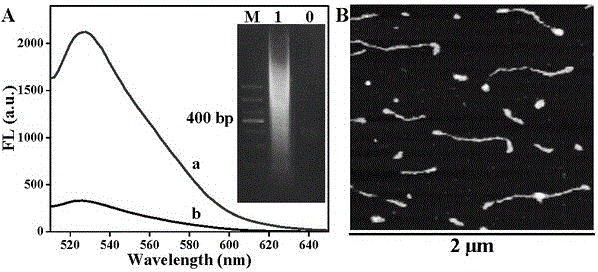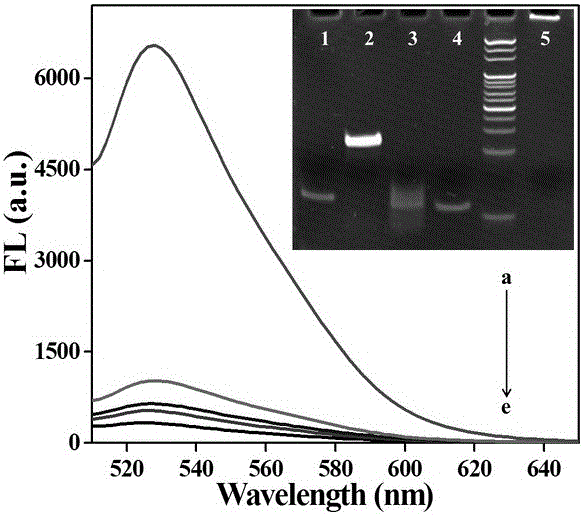MicroRNA detection method based on Hg<2+> assistance and double-polymerase isothermal nucleic acid amplification technology
A technology of isothermal nucleic acid amplification and detection method, which is applied to the determination/inspection of microorganisms, biochemical equipment and methods, etc., to achieve the effect of sensitive detection
- Summary
- Abstract
- Description
- Claims
- Application Information
AI Technical Summary
Problems solved by technology
Method used
Image
Examples
Embodiment 1
[0019] (1) Mix microRNA and template DNA (cpDNA), anneal and hybridize at 80 °C for 5 min, then slowly cool to room temperature, and add polymerase-containing Klenow fragment (KFexo - ), deoxythymidine triphosphate and terminal deoxynucleotidyl transferase (TdTase) in 20 mM pH 7.9 with 50 mM KAc, 10 mM Mg(Ac) 2 and 0.25 mM CoCl 2 tris acetate buffer solution, reacted in 37 ° C water bath for 3 h, made polythymine base sequence, added Hg 2+ After mixing completely, react isothermally in a water bath at 37 °C for 1 h to form T-Hg 2+ -T double-strand structure solution;
[0020] (2) Add 5 μL SYBR Green І to T-Hg 2+ -T double-strand structure solution, mixed and transferred to a centrifuge tube, with 10mM pH 7.5 containing 50mM NaCl and 10mM MgCl 2 Tris hydrochloride buffer solution was diluted to 200 μL, reacted at room temperature for 10 min, in a quartz cell with an optical path length of 1 cm, when the excitation wavelength was 490 nm and the scanning range was 510-650 nm,...
Embodiment 2
[0023] The effect of two polymerases on the reaction during polymerization was studied by fluorescence spectroscopy and polyacrylamide gel electrophoresis. Depend on image 3 It can be seen that in the cpDNA+microRNA-21 solution, only when the polymerase KFexo - In the presence of TdTase and TdTase, the fluorescence signal of SYBRGreen І was significantly enhanced (curve a), while only one of the polymerases or no polymerase, only a very weak fluorescence signal (curve b-e), the above results show that the amplification of the fluorescence signal Depends on polymerase KFexo - and TdTase co-action. Polyacrylamide gel electrophoresis analysis of reaction products of double polymerase extension thymine (inset), when only polymerase TdTase or KFexo - When , no amplification product was generated (bands 1-4); while when the polymerase TdTase and KFexo - When added at the same time (lane 5), a large amount of amplification product was generated, which was so long that it remained ...
Embodiment 3
[0025] Figure 4 is the change of SYBR Green І fluorescence intensity with the concentration of microRNA-21. The fluorescence intensity of SYBR Green І increases with the increase of the concentration of microRNA-21. The concentration of microRNA-21 is in the range of 10 pM-10 nM. The fluorescence intensity of SYBR Green І has a good linear relationship with the logarithm of the concentration of microRNA-21 (inset ), the detection limit of microRNA-21 was 5 pM.
[0026] In order to evaluate the specificity of this method for the detection of microRNA-21, a control experiment was carried out: microRNA-210, microRNA-141 and single base mismatch (SM) microRNA-21 were used as negative controls, and samples without microRNA-21 were Blank control (Blank), the results are as follows Figure 5 shown. In the presence of MicroRNA-210 and microRNA-141, the fluorescence intensity of SYBR Green І was similar to that of the blank control; in the presence of single base mismatched microRN...
PUM
 Login to View More
Login to View More Abstract
Description
Claims
Application Information
 Login to View More
Login to View More - R&D
- Intellectual Property
- Life Sciences
- Materials
- Tech Scout
- Unparalleled Data Quality
- Higher Quality Content
- 60% Fewer Hallucinations
Browse by: Latest US Patents, China's latest patents, Technical Efficacy Thesaurus, Application Domain, Technology Topic, Popular Technical Reports.
© 2025 PatSnap. All rights reserved.Legal|Privacy policy|Modern Slavery Act Transparency Statement|Sitemap|About US| Contact US: help@patsnap.com



